Interesting and Fun
Interesting, But I Could Do Without It
Out doing stuff in the garden, I sometimes wonder: What’s fun about gardening? What’s interesting about gardening?
European hornets are interesting. My first encounter with them — large, intimidating looking hornets with fat, yellow and black striped bodies, was a few years ago when I saw it feeding on kitchen trimmings as I was about to add more to the compost pile.

The thought of a sting from this brute seemed horrendous; I learned, though, that they’re not particularly aggressive and their sting belies their ferocious look. The menacing-looking brute that entered the schoolyard turned out to be a pretty nice guy.
My next significant encounter with European hornets was this week, as I was gazing up into the branches of my plum tree admiring the ripe, red plums, ready for harvest. Reaching up and picking a fruit left me in hand with hardly more than the shell of a fruit that had been eaten out from the inside via a large hole chewed on the far side. In another fruit, I saw the culprit — a European hornet — at work. Lots of plums were being destroyed, as well as near-ripe apples.
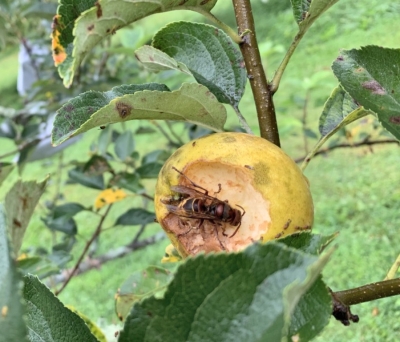
How interesting (and unfortunate). Now, what to do. Deb immediately suggested bagging the remaining fruits. I had a stock of “Japanese fruit bags” purchased many years ago and within the hour, all remaining apples a plums were harvested, if sufficiently ripe, or bagged.
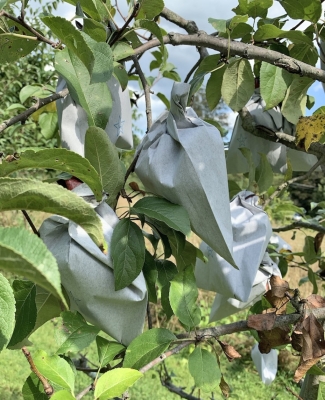
As for next year, perhaps European hornets will, as in past years, no longer be troublesome. Perhaps I’ll try trapping them; a research paper showed that they were attracted to funnel traps baited with a mix of equal parts glacial acetic acid and isobutanol. I’ll watch and wait.
Interesting, and Good
Also interesting (and this time fortunate) was the activity of local squirrels this year. Squirrels are particularly fond of peaches and plums, especially early in the season when fruits are dime-size. Not ever here, though. Good. But they are also particularly fond of my hazelnuts. Left to their own devices, they will strip the plants clean.
Over the years I’ve developed a multipronged approach to keeping squirrels at bay, usually, but not always, with success. This year, the hazelnuts were totally spared. Why? Was it my deterrents?
Now that I think of it, birds also acted out of character here this year. They usually strip every fruit from the Illinois Everbearing mulberry tree and the gumi bush. (My blueberry bushes sit within the Blueberry Temple, protected by bird netting.) This year birds again got most of the mulberries but left plenty of gumis for me.
The only time birds left all the gumis and mulberries for me was the back in 2013, the summer of the 17-year cicadas. Birds evidently relish cicadas more than my fruits.
Compost Fun
So what is predictably fun about gardening? Yesterday’s spreading of compost, that’s what.
The first of four beds of sweet corn had been harvested so I prepared the bed for an autumn harvest of “greens.” For starters, I chopped corn stalks off a couple of feet above ground level, then chopped them into smaller pieces in the garden cart. Digging around the base of each hill of plants was enough to sever the largest roots and allow the stalks to be tugged out of the ground and then also to the cart. I lightly raked off any remaining debris from the bed, pulled weeds, and then they went to . . . guess where? All this was added to a bin containing a growing compost pile.
Near that bin was another bin, a “finished” bin of dark, crumbly, and sweet-smelling (well, not sweet, but pleasantly fragrant) compost. Into the cleaned out cart it went.
Back in the garden, I demarcated the edges of the old corn bed with a line of limestone and laid a metal 2 by 4 along each edge as a guide. Into the bed went enough compost for a leveled 1-inch depth. That amount of compost, in addition to smothering small weeds, letting rainfall percolate gently into the soil, maintaining moisture in the soil, and providing food and lodging for beneficial soil life, will provide all the nourishment vegetables in that bed will need for a whole year hence.
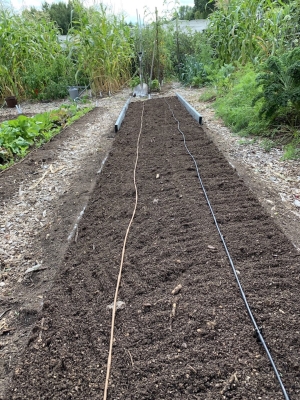
I firmed the compost by patting it with the back of my 6-pronged pitchfork creating what I, at least, thought was a nice pattern on the surface, perhaps inspired by a photo I’ve seen of a zen monk raking the gravel garden at the Ryōan-ji monastery in Japan. Final dressing on the bed was lettuce transplants, started about a month ago and ready to pop into the compost-dressed ground.
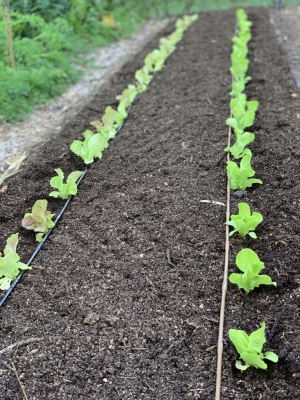

The toad liked my bed also.
Finally, I stood back and admired my work. What fun, and that bed is (to me) a thing of beauty.


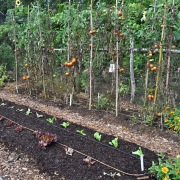

I was intrigued with the idea of a squirrel strategy, then you never told us what it is. How do you keep the furry raiders from destroying fruit?
Dogs, cats, guns, and traps. Also, placement of trees and a high grass (except right around trees).
How do you place trees to keep squirrels off them? And what sort of high grass keeps them away?
I don’t think squirrels like to go in high grass because it slows them down. Here, it’s just un-mown meadow, a mix of various grasses and other herbaceous plants that stays that way by my mowing once a year.
Lee:
Mayby I missed it. Would you briefly mention what “deterrents” you use for keeping small animals from bothering your fruit trees? What about the Japanes Fruit Bags on peaches trees?
Where can one get this product?
Many Thanks,
Ken F.
Dogs, cats, guns, and traps. Also, placement of trees and a high grass (except right around trees).
I have had unusually high activity on my fruit trees this year here in the PNW and I have watched hornets on the fruit. I wound up doing a bit earlier harvest on everything (peaches, pears, apples, & plums) yet I left a lot of the small apples on the tree for the hornets. If there’s anything left at the first frost I’ll harvest them. I dug potatoes yesterday and it was the first time in 9 years that I had ever seen a ground dwelling rodent eat potatoes but it only went after the little one’s. It’s like a switch was flipped and fall is here. I did hear in garden chatter that the Farmers Almanac is calling for a hard cold winter.
Yes, every year is different.
I don’t put any stock at all in the Almanac’s weather predictions.
In my 15 years of gardening I’ve only picked-up the “pocket” Almanac once at the local hardware store for $1.99. What I do pick-up is my own garden journal. I’m not the best journal keeper but I have tracked some important things like rains, rain barrel amounts, start & end of harvests, harvest amounts and garden discoveries. I grab it quite often to “check back” and think every gardener should attempt to keep one. It also makes a wonderful Christmas gift for those who are preparing for the holidays.
Yes, your personal garden journal is a great idea. I do keep notes also; this blog is part of that note-keeping.
Now, I am inspired to get to work on planting for fall. Thanks for the push.
Thank you for posting this interesting blog.
I am just screening and distributing my 64 cubic foot compost pile, which at 78 years of age (my age, not the compost pile), is a lot of labor, but quite satisfying, so your blog struck a resonant cord.
Incidentally, I found two ways to deter wasps at my humming bird feeders:
1. “Sticky boards” with an apple peel stuck to it will permanently attract wasps.
2. One liter soda bottles, top cut off and inverted into the bottom, filled 1 inch high with fruit, vinegar and sugar work wonders.
Hello,
Nice, I’m envious. I’m reading you book on no weed gardening. It’s an inspiring read. A question, do you have a rough idea of how much compost you produce and use in a year?
Here on California’s Central Coast making a compost pile is not straight forward. With no rain from May to October there is a limited amount green stuff available to go onto a compost pile. And it is dry enough that it’s a job to keep a compost pile moist. What is available, however, is spent mushroom compost from some local growers up the coast. How do you feel about using mushroom compost? Can it be used in roughly the same way as your “dark, crumbly, and sweet smelling” stuff?
Thanks for the good advice.
Each of my compost bins holds about 50 cubic feet and I need about 3 bins worth yearly for my vegetable beds. But I make more than that.
Yes, mushroom compost is good. It’s compost.
Hi, I really enjoy the images you post. I, too, make a fair amount of compost. But I don’t always run a hot pile or use a thermometer. So some seeds survive which means I still have to weed. Any suggestions on how to eliminate most weed seeds? I’ve had volunteer tomato plants pop up in the middle of my lettuces and strawberries. My compost bins are sided with hardware cloth for air circulation. I found these last few years the catch of having a beautiful integrated garden. The visitors I get are lovely. I enjoy their presence. But here in suburbia, with this acre oasis full of fruit trees and brambles and native species and composting I am getting significant wildlife pressures on food crops. I’ve had to add an additional woodchuck proof enclosure wire fencing inside the 6ft. Cedar fencing. Everybody’s got to eat . . .
I like solid sides on my compost pile to contain the heat and moisture therein, so more composting takes place closer to the edges. Time will kill a certain number of weed seeds; they’ll rot.
Beautiful bed, nice toad!